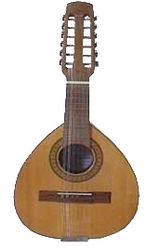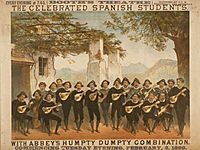Bandurria facts for kids
The bandurria is a cool musical instrument from Spain. It's a bit like a mandolin and is played by plucking its strings, often with a pick. You'll mostly hear it in Spanish folk music, but it's also popular in countries that used to be Spanish colonies.
 |
|
| String instrument | |
|---|---|
| Classification | Plucked chordophone |
| Hornbostel–Sachs classification | 321.321 and 321.322 (Necked bowl lute for roundback, necked box lute for flatback) |
| Related instruments | |
| laúd, mandolin, octavina | |
Contents
How the Bandurria Changed Over Time
The bandurria has changed a lot through history. Before the 1700s, it had a round back, looking a bit like a mandore. By the 1700s, it became flat-backed. It also started having five pairs of strings, tuned in a special way called "fourths."
From Medieval to Modern Strings
- In the Medieval times, bandurrias had just three strings.
- During the Renaissance, they gained a fourth string.
- In the Baroque period, the bandurria had 10 strings, arranged in five pairs.
- Today's bandurria has 12 strings, set up in six pairs.
- These strings are tuned in unison pairs, going up in fourths from a low G#.
- The lowest four strings are a major-third higher than a standard guitar.
- The top two strings are a fourth higher than a standard guitar.
- The notes are G♯, c♯, f♯, b, e, and a.
Bandurria Around the World
The bandurria is played in many different places. It has special uses and even different shapes depending on where you are.
Bandurria in Spain
The bandurria was first mentioned way back in the 1300s by Juan Ruiz. Later, in 1555, Juan Bermudo described it as a three-string instrument. But he also said there were types with four or even five strings.
In the 1870s, bandurria music was played at a child's wake in Jijona, Spain. Before 1900, the bandurria also helped with a dance called the "zapateo." This dance came from the Canary Islands.
Bandurria in the Philippines
The Philippine harp bandurria is a special version of the instrument. It has 14 strings and 16 frets. Its neck is shorter than the Spanish bandurria. This instrument likely developed in the Philippines when Spain ruled the country (1521-1898).
In the Philippines, the bandurria is part of a group of plucked string instruments called a rondalla. It's tuned a bit lower than the Spanish bandurria. Its notes from low to high are F#, B, E, A, D, G.
Bandurria in South America
You can find many different kinds of bandurrias in South America. They are especially popular in Peru and Bolivia. These bandurrias usually have four sets of strings. Each set can have two, three, or even four strings. They are often tuned more like a guitar, not in fourths like the Spanish bandurria.
In Lima, Peru, it was common to hear duos of harp and bandurria in the early 1900s. Even today, people in Peru still play the bandurria. It often goes along with a popular dance called the "vals peruano," or "vals criollo."
Bandurria in the United Kingdom
The bandurria isn't very well known in the UK. However, Roy Williamson, from the Scottish folk group "The Corrie Folk Trio," used one. When the group became "The Corries," Roy added a bandurria to a special multi-instrument he built. He called it a "combolin."
Famous Players
- Javier Mas, known as "Tamiz."
- Arnel Pineda
See also
 In Spanish: Bandurria para niños
In Spanish: Bandurria para niños









